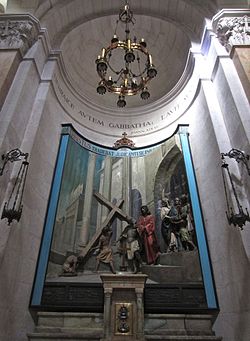- Church of the Condemnation and Imposition of the Cross
-
Church of the Condemnation and Imposition of the Cross 
Basic information Location Jerusalem Affiliation Roman Catholic Leadership Franciscan Order Architectural description Architectural style Byzantine Completed 1904 The Church of the Condemnation and Imposition of the Cross is a Roman Catholic church located within the Franciscan compound that also contains the Church of the Flagellation in the old city of Jerusalem.
Contents
Tradition
It marks the traditional spot where Jesus took up his cross after being sentenced to crucifixion.
However, this tradition is based on the mistaken assumption that on an area of roman flagstones, discovered beneath the building and beneath the adjacent Convent of the Sisters of Zion, was the pavement (Greek: lithostratos) which the Bible describes as the location of Pontius Pilate's judgment of Jesus[1]; archaeological investigation now indicates that these slabs are the paving of the eastern of two 2nd century Forums, built by Hadrian as part of the construction of Aelia Capitolina[2]. The site of the Forum had previously been a large open-air pool, the Strouthion Pool, which was constructed by the Hasmoneans, is mentioned by Josephus as being adjacent to the Fortress in the first century[3], and is still present beneath Hadrian's flagstones; the traditional scene would require that everyone was walking on water.
Like Philo, Josephus testifies that the Roman governors stayed in Herod's palace while they were in Jerusalem[4], carried out their judgements on the pavement immediately outside it, and had those found guilty flogged there[5]; Josephus indicates that Herod's palace is on the western hill[6], and it has recently (2001) been rediscovered under a corner of the Jaffa Gate citadel. Archaeologists now therefore conclude that in the first century, that the Roman Governors judged at the western hill, rather than the area around the Church of the Condemnation, on the diametrically opposite side of the city[7].
History
The original church was built during the Byzantine era. It was converted into a mosque before being restored to a Catholic church in 1904.
Design
The church is topped by five white domes, each of them sitting on drum containing stained-glass windows depicting themes from Christ's Passion. Papier-mâché figures in the apse also visually narrate stories of the Passion. In one Pontius Pilate condemns Jesus to crucifixion. Another shows John desperately trying to keep the Virgin Mary from seeing Jesus carrying the cross down the Via Dolorosa. Wall illustrations depict Pontius Pilate washing his hands, and soldiers imposing the cross on Jesus. Four pink marble pillars support the ceiling. Pilasters are found on many of the walls, and miniature Corinthian columns appear to be holding up the altar. An interesting feature of this church is the Roman period floor found next to its western wall. Typical of floors of that era, it is made of very large, striated stones that kept people from slipping as they walked.
Coordinates: 31°46′49.26″N 35°14′1.36″E / 31.78035°N 35.2337111°E
References
- ^ John 19:13
- ^ Pierre Benoit, The Archaeological Reconstruction of the Antonia Fortress, in Jerusalem Revealed (edited by Yigael Yadin), (1976)
- ^ Josephus, Jewish War 5:11:4
- ^ Pierre Benoit, The Archaeological Reconstruction of the Antonia Fortress, page 87, in Jerusalem Revealed (edited by Yigael Yadin), (1976)
- ^ Josephus, Jewish Wars, 2:14:8
- ^ Josephus, Jewish Wars, 5:2
- ^ Pierre Benoit, The Archaeological Reconstruction of the Antonia Fortress, in Jerusalem Revealed (edited by Yigael Yadin), (1976)
Categories:- Churches in Jerusalem
Wikimedia Foundation. 2010.

